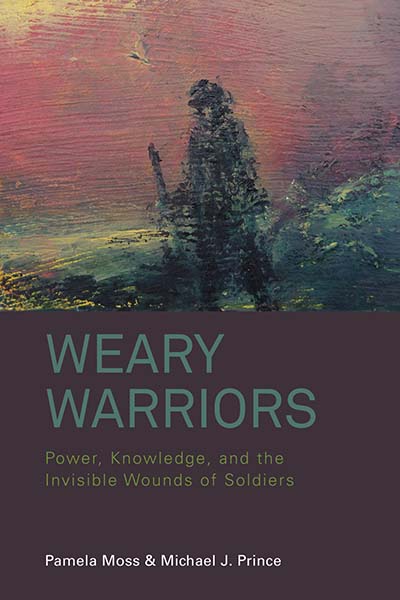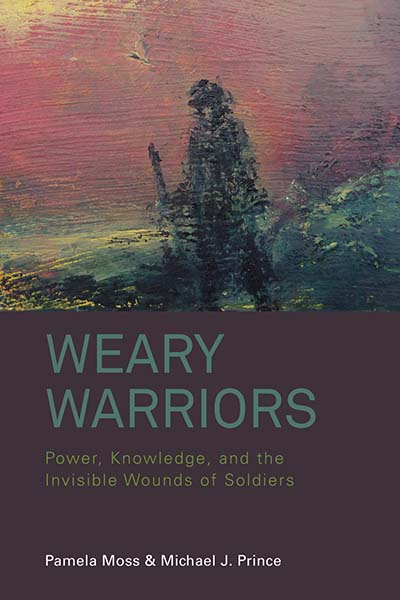
As the paperback edition of their acclaimed Weary Warriors volume is published, Pamela Moss and Michael J. Prince have kindly written this exclusive look at the issue it tackles, the profound distress and disorders experienced by military personnel. They also discuss how these effects of service have been represented by different generations in novels, television and film, notably All Quiet on the Western Front.
Weary Warriors: Power, Knowledge, and the Invisible Wounds of Soldiers is also available as an OPEN ACCESS digital edition, available here.
In Weary Warriors, we focus on the mental anguish and emotional wounds of combat exhaustion, war-related stress, operational trauma, and psychological disorders of military personnel engaged in both war operations and peacekeeping missions. We use a wide range of materials from varying time periods to uncover some of the ways in which combat stress turns into formal psychiatric diagnoses, manifests in physical bodies, and informs cultural moments.
While we refer to soldiers in the book’s title, we use the term “soldier” to denote the one who fights on orders from state-based armed forces and thus refers to a wide range of military combat personnel including, for example, sailors, pilots, gunners, and marines.
Since Weary Warriors was first published, the cause, treatment, and representation of deep emotional distress experienced by military personnel has remained a contested terrain. Disagreements over the source of mental exhaustion, whether from a psychological break or acute bodily damage, matter because they determine the path toward recovery. The contemporary reckoning within the military of sexual misconduct at multiple ranks threatens the very masculinity that reproduces the institution.
What is more interesting, however, is that during this time and within this turmoil, the topic itself has become more salient across various social, institutional, and cultural settings. Mental health matters, including emotional trauma among soldiers, have found more solid footing in public and civil discourse. Being situated as part of this wider milieu has invited more discussion and debate around the complexities of a soldier’s experiences and subsequent reactions, particularly long-term.
Ongoing engagement around mental health services by formal state offices, such as the Veterans Administration in the US government, the recently established Office for Veterans’ Affairs in the British government, and armed forces members and veterans in Canada, speak directly to the lasting influence of the devastation deep emotional distress exacts.
Yet suicide rates, risks of homelessness, and the transition to civilian life from military service persist as troubling issues and disturbing realities for far too many veterans, particularly male veterans. While early diagnosis and dedicated treatment of post traumatic stress disorder has eased part of the demand for healing, challenges linger around supporting both active-duty military personnel and veterans in terms of, for example, dismantling mental health stigma, prejudice, and discrimination, delivering sufficient and appropriate health care, and providing access to adequate housing and employment opportunities.
Across the chapters, we trace how specific forms of knowledge fuel the ways in which soldiers’ wounds are read psychologically, culturally, socially, and institutionally. All these knowledges are imbued with power – psychiatry, the military, masculinity – that not only organize the practices soldiers engage in but also the thinking about the soldier’s mind, body, and soul. To illustrate this point, we construct our arguments through temporal snapshots of the mental pain soldiers experienced during combat and are then endured for some time afterwards.
Our historical view is by no means cursory: we systematically unpack the ways power and knowledge come together and emerge in specific sites that mark soldiers’ minds, bodies, and souls with traces of these entanglements. We also show how these bodily inscriptions get taken up culturally, socially, and institutionally that often have dire consequences for the realities of soldiers’ lives.
We offer an alternative theory that reads weary warriors as minds, bodies, and souls seeking some surety within a changeable set of power and knowledge relations. Our multi-scaled analysis involves forays across battlefields, movie theaters, medical clinics, diagnostic documents, and military offices. We capture snippets of life where the military, psychiatry, the public, and the state encounter soldiers’ bodies, and then act on them. Our overall goal is to generate a path through which to see just how visible these invisible wounds actually are.
Indeed, soldiers’ tales of the mental, emotional, and psychological effects of military service engage each emerging generations differently.
Film noir captured the moody atmosphere of mid-twentieth century post-war malaise via accounts of wounded soldiers attempting to transition into a transformed and fundamentally flawed society. Exposure to the absurdity of war without considering the toll exacted from individuals was also a theme of the American movie and series, M*A*S*H, in the middle and in the wake of the Viet Nam War. Even the recent updating of Magnum, PI, from Second World War and Viet Nam veterans to veterans of service in Afghanistan, speaks to the endurance of varying tales of shell shock, battle fatigue, and TBI.
Emphasis on such discord and conflict is not just a story of not fitting in, a narrative that many youth are drawn to. It is also a story about not being able to fit back in, a narrative structured around a seemingly everchanging set of vicissitudes, the viscera of which one can not quite grasp.
One of the most redoubtable anti-war statements, Erich Marie Lamarque’s novel, All Quiet on the Western Front, written in the 1920s about the Great War from a decade earlier, is also a microcosm of the cause, treatment, and effect of emotional trauma from armed combat. Through the eyes a group of young men, Lamarque traces precisely how emotional trauma emerges in situ, as part of preparing for war, being on the battlefield, and planning for the war’s aftermath. The Academy award-winning film, by Russian-born American director Lewis Milestone, released in Germany in 1930, was met with fierce resistance, intimidation, and violence by those supporting the rising Nazi party, which subsequently led to its banning in Nazi Germany.
As recent as 2022, German director Edward Berger, brought the novel to film again introducing the story to yet another generation of youth. Its popularity and critical acclaim lays bare the unremitting fascination of society with war and trauma. This ongoing resonance is not just a mawkish exultation of the human cost of war. It shows just how deeply we care about the casualties of the minds, emotions, and souls of soldiers.
A central message in our book is that weary warriors need to be taking up their place within society, at home, and in their lives without being marked with an ostracizing mental illness, while feeling alive and ready to engage in living every single day and having ample and appropriate support to reduce suffering.
Various attempts to care for soldiers and veterans arise from a more widely based notion of caring about soldiers and veterans. Vital to caring in any sense, however, is the need to understand.
Gaining insight into the effects of various configurations of power and knowledge, including future analyses of moral injury, toxic masculinity, structural racism, and political extremism, can open up more space to address the restrictions imposed on the burned-out soldiers’ minds, bodies, and souls. Paramount in creating these spaces for the individual is being able to navigate the dissonance of battleground of symptoms, varying diagnostic tools, and rival treatment methods muddled by different mixes of care and coercion side by side with the contending imperatives of the armed forces, the creed of a practicing psychiatrist, and constructs of masculinity.
PAMELA MOSS is a Professor Emerita in Human and Social Development at the University of Victoria, British Columbia, Canada. She co-authored with Isabel Dyck of Women, Body, Illness (Rowman and Littlefield, 2003), edited with Katherine Teghtsoonian Contesting Illness (University of Toronto Press, 2008), and wrote and edited with Karen Falconer Al-Hindi Feminisms in Geography (Rowman and Littlefield, 2008). She worked on a series of articles on collective biography with Karen Falconer-Al Hindi, Roberta Hawkins and Leslie Kern published across several geography journals.
MICHAEL J. PRINCE is Lansdowne Professor of Social Policy at the University of Victoria, British Columbia, Canada. He is author of Absent Citizens: Disability Politics and Policy in Canada (University of Toronto Press, 2009), co-author with James Rice of Changing Politics of Canadian Social Policy, 2nd edition (University of Toronto Press, 2013), author of Struggling for Social Citizenship: Disabled Canadians, Income Security, and Prime Ministerial Eras (McGill-Queen’s University Press, 2016), and wrote and co-edited with Daniel Béland and Greg Marchildon, Universality and Social Policy in Canada (Toronto: University of Toronto Press, 2019).

WEARY WARRIORS
Power, Knowledge, and the Invisible Wounds of Soldiers
286 pages, bibliog., index
Paperback 978-1-80073-739-6
OPEN ACCESS eBook 978-1-78920-110-9
Hardback 978-1-78238-346-8
For the latest news on our books and journals please sign up for our email newsletters.
